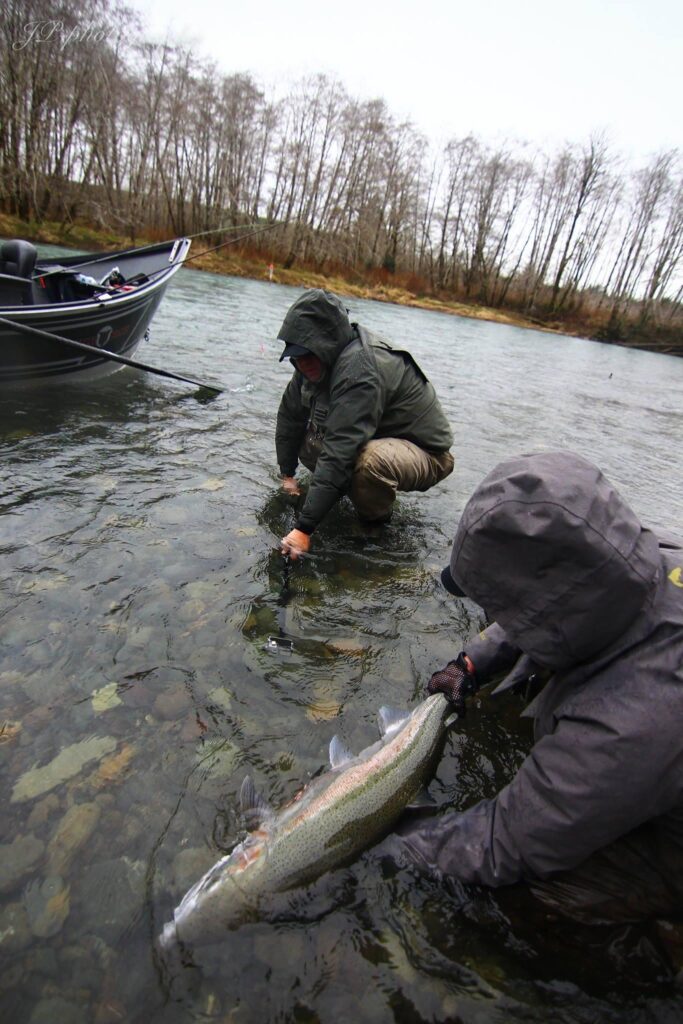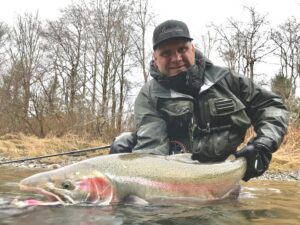
The Great lakes are Home to the World’s Largest steelhead Population on Planet Earth. Annually we stock in the region 5.2 million Steelhead every Year. So, if you’re a veteran steelhead angler or just getting started, you should know catching these excellent Game Fish 10 months out of the Year in Michigan is possible. Knowing and understanding, we have such a fantastic fishery, but if you do not possess the skills or knowledge in helping you find these fish, you can spend many days on the river scratching your head.
Many veteran steelhead anglers already know that water temperature and flow dictate where Steelhead will rest and lye. But through the years, I’ve noticed some characteristics about these fish’s behavior that can increase your odds of putting more fish in the net. No one will disagree an angler must find where the fish are to catch them. Common sense says you can’t catch something that’s not there. We will discuss some obvious places and point out some that many anglers might not notice.
Migration
Any angler targeting Steelhead needs to know that these fish are always on the move and very nervous creatures. They have a sense of urgency like any other fish I’ve seen. Remember, these fish sometimes arrive six months or longer ahead of schedule and stay while waiting for the spawn. They are constantly on the move. An angler must divide a river system into four sections. The Lower, Middle, Upper, and Headwater sections. Due to these fish always moving, the Middle and Upper River sections automatically give you better odds of finding some fish.
Steelhead tends to move upstream when the river rises or falls constantly. There are usually only two things that will make these fish put on the brakes: colder Water temperatures and low water conditions. Most anglers do not realize that these fish are somewhat predictable, just as other species. Suppose you familiarize yourself with the fish’s habits and some biological facts. These fish are just like white-tailed deer during the winter. Deer will always pick the most accessible easy route when traveling. These fish will always choose the path of least resistance if unpressured and not spooked. Not to say the fish won’t jump or go through barriers that you wouldn’t expect a fish to go through. They always will find a way, but they will take it if there’s an easier way.
So, we must pay attention to how that section of the river looks for migrating fish. Maybe slower or deeper water for the fish to pass through rather than a raging rapid. These fish are genetically programmed to conserve energy while in the river for the upcoming spawn. Hence, they are always looking for current breaks and places to rest for the journey upriver. A distance of 30 miles in one day with no obstructions for a healthy adult steelhead is not a problem. As you can see, these fish can cover some serious water in a short amount of time if they want to.
So, if your 2 or 3 days behind a high-water event, you better head upriver to find fish instead of down low. Those pods of fish will be upriver by then based on water temps and flow.
Please keep in mind many factors affect this strategy. They are Steelhead. We will never completely figure them out. One thing is for sure: if more arriving fish come up the river from behind those holding, that first wave of fish will push up the river. Its mother nature’s way of spreading the fish out. Hence, November is such a hot month to catch Steelhead in Michigan. Many fish have arrived at the party by then and have spread out through the system. Not to mention many guys are away at deer camp.
Low Light or Night-Time is when these fish move the most many anglers think. In my opinion, that’s not always the case with these fish. If the proper flow and barometric pressure exist on overcast days, they will undoubtedly push in daylight. When these conditions exist, pray for a bright sunshiny day. The extra light will slow the migration down, and these fish will park in the deeper holes or broken water to hide and then continue their journey under cover of darkness.
Structure
The structure is a beautiful thing when it comes to fishing. No question, fish will orient to structure for security from other predators and to set up ambush points for baitfish or food. Logs are the most visual above the water that an angler can see most of the time. This structure can be great for finding fish, offering current breaks, and creating seams for Steelhead to hold and rest. The downside to this type of structure is sometimes, if the log isn’t big enough to anchor itself, one good blow out of the river and mother nature will send that log on its merry way. I have written about how a river is an ever-changing place in past articles. It can vary from Year to Year. One hole that produced fish and was great can change. Some rivers I’ve fished for years have logs that have been there for as long as I can remember.
The structure can also create pocket water which can be fish magnets for migrating Steelhead. My favorite structure, if you can find it is boulders. The beauty of boulders is they usually are always there. So once that structure has been located, you can go back Year after Year and find fish there. The same goes for cement, pilings, or retaining walls. These are overlooked items that attract fish.
Terrain features above the water lead you to clues to find more fish. Any on-off exit ramps of terrain are great clues. Most flat water has a flat bottom that has a spot tilting upwards. Also, look for drop-offs and depressions on your electronics. Small depressions and drop-offs are overlooked by many anglers within a river system and are sometimes missed. Look for the darker areas if you do not own some electronics.
Many well-known rivers with famous names for run or holes have structure, which is why most are so good, no doubt.
Reading Water
In this section alone, I could fill a book on this subject because all rivers’ mechanics and their run clocks are so different. They can vary based on the state, size of the river, water temperature, and flow. So, let’s cover some good nuggets of info that any angler can use.
Walking speed water that flattens is always an excellent spot to look for when locating Steelhead. This spot is a telltale sign of a pool. Consider fishing the head and the tail out of any pool. Always look for the softer edge of any seam, and usually, it’s the deeper side. Keep in mind that most Steelheads are most likely caught in 4-8 ft of water. The exception to this rule would be during the spring run when fish are spawning in 2ft of water often.
Holding lies are typically when a main current seam is broken. You can usually find some active fish there most times. The best water temps for Steelhead are 42-58 degrees. At these temps’ the fish are happy and most active, and you can expect to get them to bite. At these temp’s faster water is the usual rule. Once water gets below 42 degrees or less, start looking for slower, deeper pools. These conditions are the typical wintertime spots here in the Great Lakes. Caution do not discount faster water in the High 30’s temp. Range. I’ve seen steelhead hold in much faster water when you think they would be in slow deeper pools. Remember, they are Steelhead; make sure to fish it all. Bottom line: Once you find fish and see what water they prefer that day, you should be able to replicate it throughout the system.
Steelhead will always hold in slower water closer to the shoreline if you have higher water conditions, and they love the inside or outside bends. Corners and V’s where two currents meet and are steelhead magnets. Also, look for ledges and drop-offs. These fish love them. During high angling pressure, look in the tail outs other holding water near a well-known hole or lie. Pressured fish will push back or scatter around the run and temporally hold to get away from anglers. These are areas to try different colors and baits that fish have not seen. If the bite slows, always change colors before leaving. Every river steelhead angler out there fishes a pink spawn bag. Something different puts fish in the net. In most cases, being different is a good thing, yet many anglers stick to the norm. Colors such as blue or red can pay huge dividends.
As you can see, an angler has to stop, slow down and assess the water and read the water and pay attention to all details. Break the run into sections or use a grid pattern landmarks and structure. I like to be very thorough. This way you don’t miss fish. Thinking like a fish, where would I be the most comfortable based on the current conditions. You will catch fish many anglers miss and don’t find.
Conclusion
Analyzing weather, water flow, and temps before you go fishing will help big time with your success. Once on the river, using a careful, methodical approach, looking for the proper structure, and reading the suitable water based on the seasonal conditions will help you find fish. Once you find them, it’s up to you to deliver them to the right bait, lure or fly and get them to bite. Warning catching the mighty Steelhead can be very addicting. The only way to get your fix is to catch more fish.
Good Luck!
Roger Hinchcliff

This year I’m going to try to catch my first steelhead .
Great pieces of a never ending puzzle. F>{I<!ng Steelhead
I’ve been steelheading for about 45 years and have huge numbers of fish to my credit. One thing for sure this article will make your average Joe a much better fisherman for sure. Well written article, thank you for informing people with your knowledge.
Great Article….wealth of information